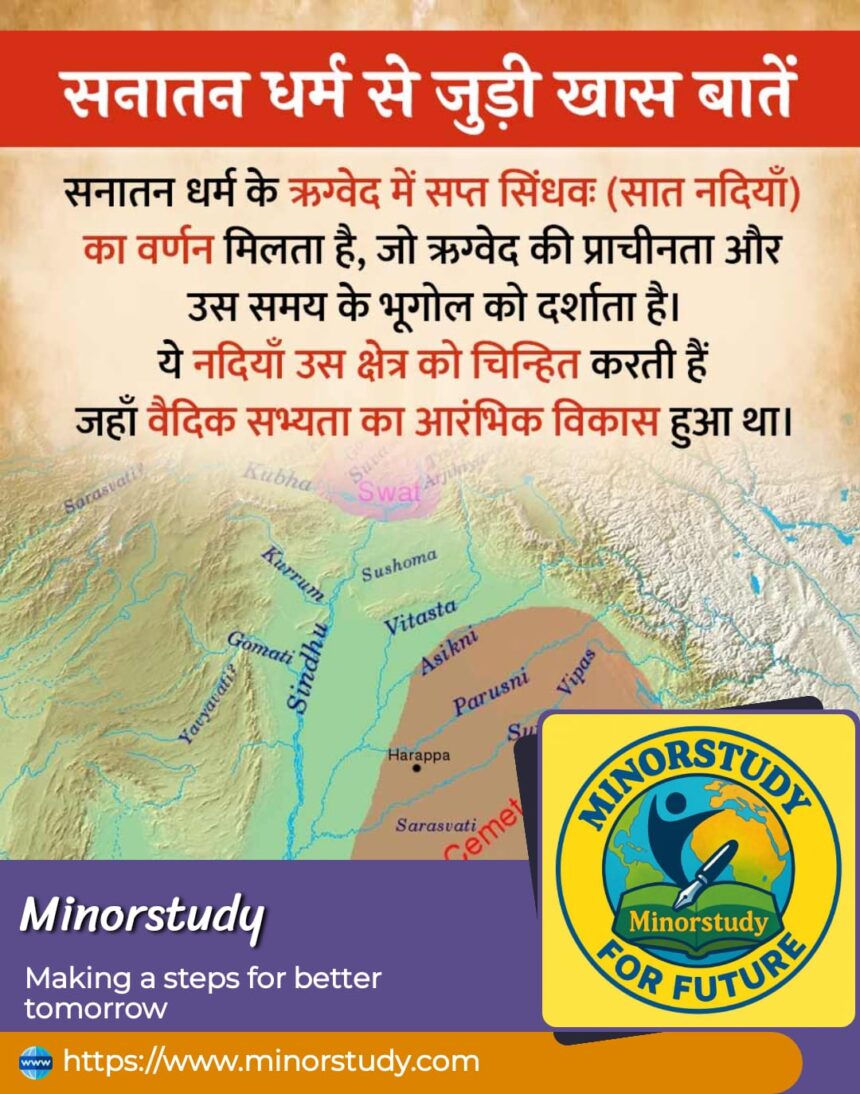🌊 7 Sacred Rivers of Sanatan Dharma: History, Geography & Deep Cultural Impact
Sanatan Dharma, often referred to as the “eternal way of life”, holds profound reverence for nature, especially rivers. In the ancient hymns of the Rigveda, there is a captivating mention of Sapta Sindhu—the Seven Sacred Rivers—that were the cradle of the early Vedic civilization.
- 🕉️ Historical Context of the Sapta Sindhu in Rigveda
- 🗺️ List of the 11 Sacred Rivers Mentioned (Including the Sapta Sindhu)
- 🔍 Facts About the Sapta Sindhu
- ❓ FAQs about Sapta Sindhu and Their Relevance
- Q1: Are these rivers still flowing today?
- Q2: Why are rivers worshipped in Sanatan Dharma?
- Q3: Is the Sapta Sindhu different from the Ganga or Yamuna?
- 📿 Spiritual & Cultural Significance
- 🌍 Why These Rivers Are Still Important Today
- 🎯 Major Observances Connected to Rivers
- 💬 Wishing Message for Sapta Sindhu Reverence
- 🔑 Key Points Summary
- 🧠 Conclusion: Why These Sacred Rivers Still Matter
These rivers were not just geographic features; they were living, breathing divinities that nourished the land, people, and spirit of India. Let’s explore the history, timeline, facts, significance, daily impact, and why these rivers still flow through the soul of Sanatan Dharma.
🕉️ Historical Context of the Sapta Sindhu in Rigveda
🗓️ Vedic Age Timeline
| Period | Development |
|---|---|
| c. 1500 BCE | Arrival and settlement of early Vedic tribes |
| c. 1200 BCE | Composition of the Rigveda begins |
| c. 1000 BCE | Geography and deification of rivers in Vedic hymns |
| c. 700 BCE onwards | Cultural expansion from river valleys to Ganga plains |
The Rigveda, the oldest known Indo-Aryan text, composed in Vedic Sanskrit, mentions Sapta Sindhavaḥ (RV 8.24.27), referencing the region of seven rivers in the northwestern Indian subcontinent.
🗺️ List of the 11 Sacred Rivers Mentioned (Including the Sapta Sindhu)
Here are the rivers that were either directly part of the Sapta Sindhu or mentioned in related Vedic texts:
| River Name | Modern Name | Region |
|---|---|---|
| Saraswati | Lost/Vague | Haryana-Rajasthan |
| Kubha | Kabul River | Afghanistan |
| Swat | Suvastu | Pakistan (Swat Valley) |
| Kurrum | Kurram | NW Pakistan |
| Sushoma | Haro River | Pakistan |
| Yavyavati | Zhob | Balochistan |
| Gomati | Gomal | Pakistan |
| Sindhu | Indus River | Pakistan |
| Vitasta | Jhelum | Kashmir |
| Asikni | Chenab | Punjab (India & Pakistan) |
The core Sapta Sindhu traditionally includes Sindhu, Saraswati, Vitasta, Asikni, Kubha, Gomati, and Sushoma.
🔍 Facts About the Sapta Sindhu
🛕 These rivers are referred to as “nadi-devatas” (river goddesses) in the Vedas.
📜 The Rigveda (10.75) dedicates a complete hymn to the rivers, led by Sindhu.
🌎 They form the foundation of the Vedic civilization, which later shaped the culture of entire South Asia.
🧭 The word “India” is derived from the Sindhu (Indus) River via the Persian Hindus.
🌊 Saraswati, once a mighty river, dried up due to tectonic shifts and climate change, but remains spiritually significant.
🔥 The seven rivers symbolized the seven-fold flow of wisdom, sustenance, fertility, sacrifice, purity, connection, and divinity.
📚 The region between Saraswati and Drishadvati is called Brahmavarta, the cradle of Hindu dharma.
❓ FAQs about Sapta Sindhu and Their Relevance
Q1: Are these rivers still flowing today?
Most of them are—Sindhu, Vitasta, Kubha, Gomati, etc., still flow. Saraswati has largely disappeared but is believed to exist underground.
Q2: Why are rivers worshipped in Sanatan Dharma?
Because they sustain life—agriculture, drinking water, culture, and transport—and are seen as divine manifestations of Mother Nature.
Q3: Is the Sapta Sindhu different from the Ganga or Yamuna?
Yes. Sapta Sindhu refers to a region northwest of present-day India, whereas Ganga and Yamuna became prominent post-Vedic.
📿 Spiritual & Cultural Significance
🌸 Purity: Rivers cleanse the soul; many rituals are incomplete without river water (jal).
🕊️ Liberation (Moksha): Bathing in sacred rivers is said to purify karma.
🧘 Meditative Flow: The flowing river is a metaphor for life and consciousness.
🛕 Pilgrimage: Many tirthas (holy sites) are along these rivers (e.g., Haridwar, Prayagraj, Varanasi).
🌍 Why These Rivers Are Still Important Today
In Daily Life:
🚿 Water from rivers like Ganga and Yamuna is used in daily worship and abhishek.
🏞️ Spiritual tourism boosts local economy and employment.
🌾 Irrigation sustains millions of farmers.
In Society:
🎓 Understanding river systems teaches us climate awareness and water conservation.
🏞️ River restoration projects (like Namami Gange) reflect ancient respect in a modern context.
🎯 Major Observances Connected to Rivers
| Festival | Description |
|---|---|
| Makar Sankranti | Holy dip in river to mark sun’s northward movement |
| Ganga Dussehra | Celebrates descent of Ganga to earth |
| Magh Mela | Ritual bathing in confluence of rivers |
| Kumbh Mela | World’s largest religious gathering at river confluences |
💬 Wishing Message for Sapta Sindhu Reverence
“May the sacred rivers of Sanatan Dharma flow eternally within and around us, purifying our hearts, nourishing our souls, and guiding our lives toward dharma and light.”
🔑 Key Points Summary
| Point | Insight |
|---|---|
| Ancient Texts | Rigveda mentions 7+ rivers central to Vedic life |
| Divine Connection | Rivers are seen as mothers and goddesses |
| Cultural Relevance | Rituals, festivals, and scriptures revolve around rivers |
| Environmental Learning | Rivers teach balance, flow, and harmony with nature |
🧠 Conclusion: Why These Sacred Rivers Still Matter
The Sapta Sindhu isn’t just a historical or mythological concept—it’s a living legacy. These rivers helped shape the spiritual, ecological, and cultural fabric of what we now know as India and Bharatvarsha. They are the arteries of dharma, the channels of culture, and the soul of the Vedic civilization.
When we revere rivers, we revere life itself. Let us not just worship them, but also protect them, so they can continue to nurture generations to come.








